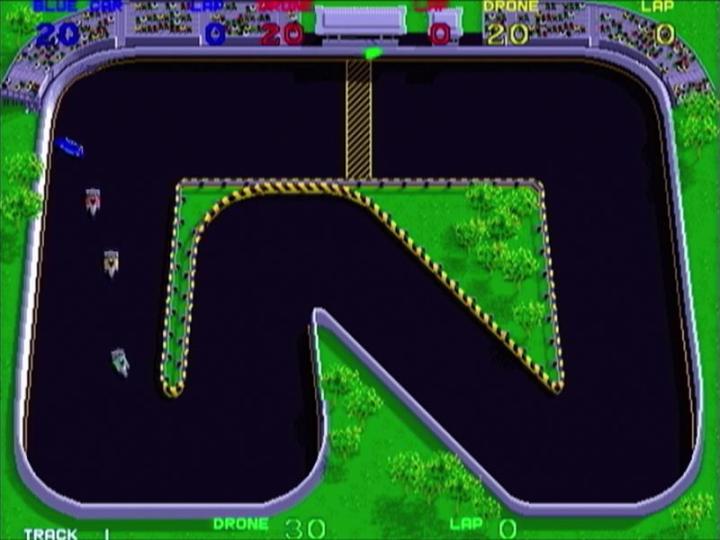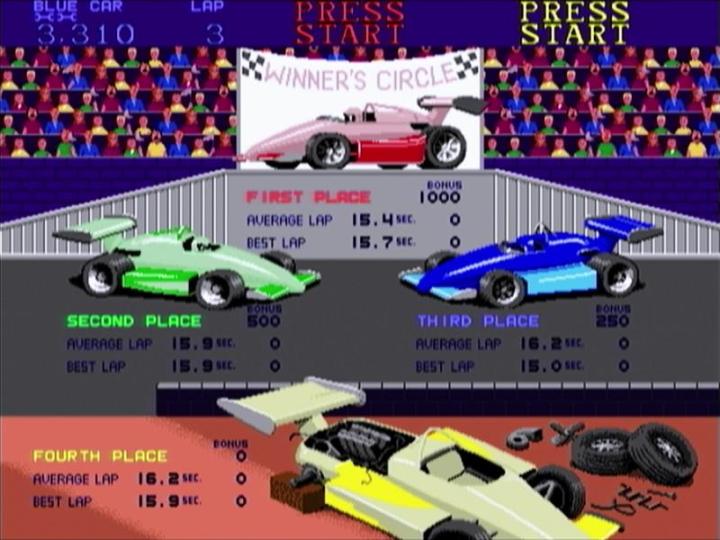Racing games are one of those genres that have undergone numerous changes over the course of gaming history — and this was particularly true in the early days.
These days we tend to think of a hard divide between “arcade racers” and “sim racers”, with the difference being largely in terms of mechanics and game structure. But back in the earliest days of gaming, racing games varied in terms of how they actually presented the action, too.
Atari Games’ Super Sprint, which came out in 1986, is a great example of a typical single-screen top-down racer from the mid-’80s, a subgenre of racing game that was popular in both the arcades and on home computers. Indeed, Super Sprint itself actually enjoyed some very competent home ports, particularly on the 16-bit Atari ST.

Super Sprint is a successor to Atari’s earlier Gran Trak 10 and Sprint games, both of which helped to establish and popularise racing games in the arcades of the mid 1970s. They also helped demonstrate how this type of game could be competitive, too — after the success of Pong, Atari knew very well that the opportunity for players to compete with their friends would get those quarters rolling in at a much higher rate than if the game was a purely solo experience.
Super Sprint hails from a time after Atari split into several pieces in 1984; the part that would become Atari Games (and later Midway Games West, hence Super Sprint’s presence in the Midway Arcade Treasures compilations) was the part that was retained by Warner after they sold the home computer and consumer products division to Jack Tramiel. As such, despite the fact that the name “Atari” has belonged to a ridiculous number of organisations over the years, Super Sprint actually has a direct connection to its spiritual predecessors.
In Super Sprint, you and up to two other players take on the role of racing drivers competing in a series of circuit races that unfold on single-screen racecourses with no scrolling. You control the car by steering left and right and using an accelerator pedal; there’s no “braking” as such, so slowing down is simply achieved by letting go of the accelerator.

Super Sprint’s handling takes a bit of getting used to, particularly if you’re playing a home conversion using a joystick or controller rather than the original arcade game’s steering wheel. The cars are rather responsive — to a perilous degree if you’re moving at speed — and as such you’ll need to take great care when negotiating more complex courses.
To make matters worse, the further you progress in the game, the more hazards you’ll have to deal with, including oil slicks and water puddles, rising and lowering bollards, tornadoes and, of course, your fellow racers. Clipping something can cause you to spin or skid out or, in the case of more serious crashes, destroy your car completely; in the latter case, you need to get a new car dropped in by helicopter before you can continue, wasting precious time.
In order to progress in Super Sprint, you need to win each race; after three laps, the driver in first place advances to the next race, while other players have to continue. While three people can play, there’s always a fourth green “drone” car as well; because of this, it’s possible for all three human players to be knocked out at the end of a race if they fail to beat the computer.
Time spent in the lead scores you points, as does collecting numerical pickups on the track. Arguably the most valuable things to make sure you grab, though, are the spanners; collecting a total of three of these means that before the next race you can upgrade an element of your car: top speed, traction or speed; if you’ve been successful for long enough that your car is fully upgraded, three spanners can instead be spent on a score bonus.

The trouble is some of these upgrades feel like a liability before long — particularly increases to your top speed. On the more complex tracks, your car can feel barely controllable at times, so making it go even faster makes for even more of a white-knuckle ride — to a frustrating rather than fun degree after a while. You even need to take care with the traction upgrades; taking these too far means it’s even more difficult to make sure your car ends up facing the right direction because it just turns too fast!
Like many of Atari Games’ titles, Super Sprint is extremely difficult, particularly if playing solo. It’s rewarding when you get a feel for the car’s handling and how best to handle each of the eight possible tracks — and the obstacles that are subsequently added on each new “loop” through the complete circuit — but there’s a pretty steep learning curve to begin with, meaning that experienced players can easily dominate novices, which isn’t all that fun for some people.
That said, when played with a group of people who are all on a relatively similar skill level, Super Sprint can be a lot of fun — particularly when played in a format such as Midway Arcade Treasures, which allows everyone to continue as much as they please and simply allow the group to race together until everyone has had enough.

As frustrating as it can be at times, Super Sprint is still a genuine classic, and one that is well worth busting out when you have some friends over. Just don’t expect to master it immediately — you’ll be seeing that rescue helicopter a fair few times in your first few races, I suspect!
Screenshots from the Xbox version of Midway Arcade Treasures.


One thought on “Midway Arcade Treasures: Super Sprint”